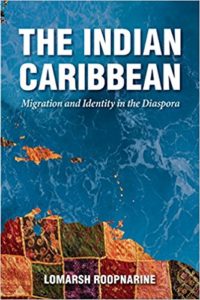Books
Beyond the Coolie Identity in the Caribbean
![Square in Oranjestad, Aruba island in Caribbean Nov. 2 2012 [Representational Image]](https://littleindia.com/wp-content/uploads/2017/10/west-indies-bigstock.jpg)
Square in Oranjestad, Aruba island in Caribbean Nov. 2 2012 [Representational Image]
Bigstock
Indians have overcome racism, discrimination and exploitation to find their place in the Caribbean.
“The word coolie is the most explosive word in the Caribbean Indian experience. If there was ever a unifying theme among the descendants of indentured Indians around the globe, it was the word coolie,” says Lomarsh Roopnarine, an expert in Indo-Caribbean history.
A racial slur in the Caribbean, with roots in the days of indenture and plantation prison, coolie essentially meant laborer but in the most demeaning way possible.
Choosing Indentured Labor Over Poverty
The coolies were the people brought to the Caribbean as cheap labor under contracts. Hoping to rise above the extreme poverty they faced in India, they voluntarily enlisted themselves to work as laborers abroad, including the sugar plantations in the Caribbean.
“The movement of Indians to the Caribbean was part of the larger movement to have Indians replace slave labor wherever Africa slavery was abolished,” Roopnarine, the author of the upcoming book, The Indian Caribbean: Migration and Identity in the Diaspora, tells Little India.
But the move did not give the Indians respite from their struggles in India. Roopanarine describes the plantations as “prisons without walls”.

Lomarsh Roopnarine
“Indians were subjected to strict labor laws and long hours of arduous work,” he explains. “The entire indenture system was characterized by injustices, particularly towards Indian women. The imbalanced male-female ratio was the reason behind atrocities such as abuse, rape and even murder of the women by their own Indian counterparts as well as from the planter class.”
But despite the harsh conditions in the plantations, Indians continued to move to the Caribbean. About 3,000 to 4,000 Indians came to some of the colonies every year.
Assimilating into the Community
The contracts under which they came promised them “free” housing, rights to return, fixed daily wages, and continuous employment with one employer.
After their contracts expired they could either choose to leave, or stay back and get a small of piece of land in exchange of their work.
“Of the estimated 500,000 people shipped from India during indenture, about two-thirds chose to stay in the Caribbean — a majority in Guyana, Trinidad, and Suriname,” says Roopnarine, a professor of Caribbean and Latin American Studies at Jackson State University.
In colonies such as St. Lucia, Grenada, St. Vincent, and Jamaica, Indians formed a minority, and were absorbed into the Creole community, aided by factors such as their small population size, the role of Christian missionaries, inter-ethnic marriages, and the exposure to western education and employment opportunities.
In these mixed communities, Indianness started to disappear as they lost touch with India or and even the Indian diaspora in the Caribbean.

In contrast, in places where Indians were a majority population, such as Guyana, Trinidad, and Suriname, they ended up owning land post-indentureship, and witnessed cultural assimilation and political participation. They engaged in business, had access to education and retained strong connections with India.
Dougla Identity
As the Indians assimilated into the African community, a Dougla (dual) identity emerged, especially in places such as Trinidad and Tobago and Guyana. Calling it Douglarization, Roopnarine adds that those born from relations between an Indian and African were seen through the lens of embarrassment and shame.
“If an Indian woman marries or lives with an African man, she is most likely to be ostracized by her Indian family although this rejection is seen more in rural than urban areas. Whereas if an Indian man marries or lives with an African woman, he will most likely be able to enter both communities —African and Indian — although with some apprehension,” says Roopnarine.
Overcoming Challenges
The discrimination and exploitation may have decreased over the years but about 40 per cent of Indians in the Caribbean still live in poverty, and the figure is much higher in Guyana. These Indian communities have experienced high rates of suicide, mass migration, domestic abuse, and wealth disparity.
However, Indians have been able to dominate the agricultural and business sectors in many Caribbean countries. Some play a big part in the rice industry in the Berbice region of Guyana, and New Nickerie in Suriname, and have become an economic force in trade, commerce, and business in Trinidad.
Today, there is a new flow of contemporary Indians to the Caribbean. Many of them are business persons with open retail business, while others are bankers, doctors or teachers.
Dilution of Indian Identity
The most significant aspect of embracing a second home was the fading of caste and religion. “The Indians formed close social ties of Jahaja Bhai and Bahin (ship-brothers and sisters) across caste and religion and created a semblance of lost India through religions, festivals, and feasts,” Roopnarine explains. “There is no division between the Hindus and Muslims. Their caste system also broke down in the face of pressure from a western-oriented plantation system.”
But a general sense of cultural awareness, assertiveness, and pride about Hinduism, Islam, music and dance still persists across Guyana, Trinidad, and Suriname.
However, for most Indo-Caribbeans, the connection to India now remains limited to Bollywood and cricket. Assimilation into the African communities was the way they survived but once in a while a gentle tug of nostalgia often has them reaching out for roti and dal.




1 Comment